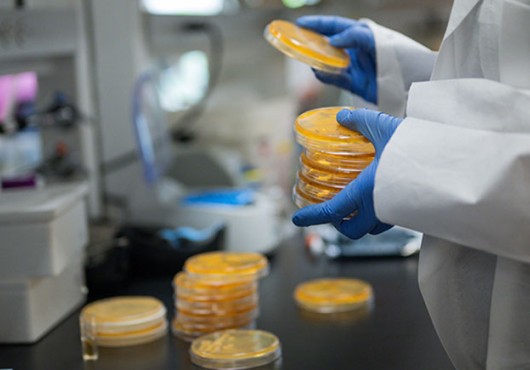
The thymus gland, shown here, is the birthplace and training ground of T cells. New research shows thymus cells assume various identities to teach nascent T cells how to distinguish friend from foe. Image: Daniel Michelson, Mathis/Benoist lab, HMS
The human immune system is a nearly perfect defense mechanism. It protects the body from disease-causing bacteria, viruses, and other pathogens. It detects nascent tumors and eradicates them. It cleans up cellular debris at the site of injury or infection.
To perform its myriad functions, the immune system must, above all, differentiate between self and non-self—a remarkable selective ability that allows it to detect and disable harmful agents while sparing the body’s own tissues.
If the immune system fails to make this distinction, it can mistakenly launch an assault against the body, causing autoimmune disorders.
Researchers have known the general principle underlying this selective ability for some time, but exactly how immune cells learn to distinguish friend from foe has remained less well understood.
Now, a new study led by researchers at Harvard Medical School identifies a new mechanism that explains how the body’s most powerful immune troops—T cells—learn to tell self and non-self apart.
The work, conducted mainly in mice, was published online June 16 in Cell.
The research shows that the thymus gland—the organ where T cells are born and trained—educates nascent immune cells by exposing them to proteins made by thymus cells that mimic various tissues throughout the body. Specifically, the research demonstrates that by assuming different identities, these specialized thymus cells preview for the maturing T cells self-proteins they would encounter once they leave their native thymus gland.
“Think of it as having your body recreated in the thymus,” said study senior author Diane Mathis, professor of immunology in the Blavatnik Institute at HMS. “For me, it was a revelation to be able to see with my own eyes muscle-like cells in the thymus or several very different types of intestinal cells.”
The findings, Mathis said, shed light on how the adaptive immune system acquires its ability to discern friend from foe. Glitches in this critical recognition system can have grave consequences.
“Our immune system is super powerful. It can kill any cell in our body, it can control any pathogen we encounter, but with that power comes great responsibility,” said study first author Daniel Michelson, an MD/PhD student at HMS and a researcher in the Mathis/Benoist lab. “If that power is left unchecked, it can be lethal. In some autoimmune diseases, it is lethal.”
School for T cells
T cells, so named because they mature and learn to do their job in the thymus before they are released into the body, are the immune system’s elite forces charged with multiple functions. They recognize and eliminate pathogens and cancer cells; they form long-term memory of viruses and bacteria encountered in the past; they regulate inflammation and tamp down hyperactive immunity.
But how does a newborn T cell that’s never left the thymus know which proteins are the body’s own and which herald enemy presence?
“T cells get educated in the thymus, but the thymus is not a gut, it’s not a pancreas,” Michelson said. “There’s no reason why these T cells should be able to recognize these organs before they leave the thymus.”
Researchers knew that this early training does take place in the thymus, but the precise teaching tools the gland uses have eluded them.






